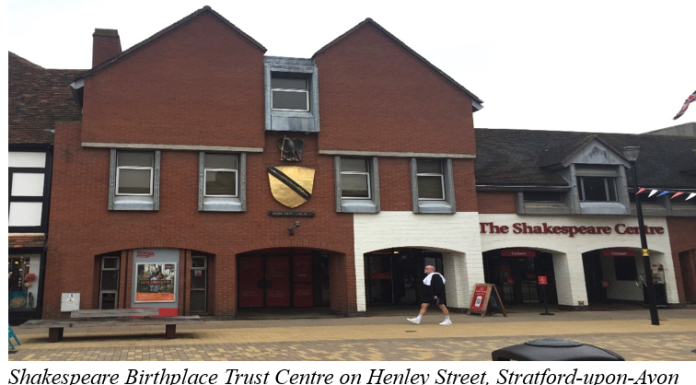In August 2023, I traveled to William Shakespeare’s birthplace, Stratford-upon-Avon (henceforth called Stratford), England, with my wife to see the places and things associated with the greatest poet and playwright of English literature. We drove from the town of Oxford, where we visited the university the day before and stayed overnight, and our plan was to spend a few hours in Stratford before heading back to our home in North Wales.
For people living in or visiting England, especially London, a trip to Stratford is on many people’s wish lists. The driving distance to Stratford is about 160 km from London and 65 km from Birmingham. However, with the entire UK having a highly efficient public transport system, it is often more convenient to leave the driving to a train or a bus ride. From London, for example, one can board a train from Marylebone Station or a bus from Victoria Terminal and make it a relaxing day trip to Stratford and back. Guided tours to Stratford are also provided by numerous travel services from virtually any major city in the UK.
The exhibits
Although Stratford is one of the major tourist attractions in England and has a population of more than 30,000, it still has a small-town charm. There is no high-rise building and no big shopping mall; most buildings are old-fashioned and have a look of antiquity on them. When we walked to the town centre from a nearby parking lot, where we had parked our car for four hours, I asked a local man where the Shakespeare attractions were, and he waved his hand around and said, “It’s all here.” One can just walk a short distance in the town centre and visit both the places where William Shakespeare lived while in Stratford. But there is more to see in Stratford that relates to Shakespeare’s life and legacy.
 For day trippers with limited time on hand, perhaps the best way to start the Shakespeare tour is to visit the Shakespeare Centre (shown as a mast-head of this article) on Henley Street. The Centre is a building of contemporary architectural design that opened on 23 April, 1964, Shakespeare’s 400th birthday. It consists of an entrance hall, a library and study centre, an exhibition area with sculptures and artworks commissioned by the trust, trust offices, and archives for Shakespeare collections.
For day trippers with limited time on hand, perhaps the best way to start the Shakespeare tour is to visit the Shakespeare Centre (shown as a mast-head of this article) on Henley Street. The Centre is a building of contemporary architectural design that opened on 23 April, 1964, Shakespeare’s 400th birthday. It consists of an entrance hall, a library and study centre, an exhibition area with sculptures and artworks commissioned by the trust, trust offices, and archives for Shakespeare collections.
The Centre sells admission tickets for the Shakespeare Birthplace Trust, which owns and manages properties related to Shakespeare in Stratford. These include Shakespeare’s Birthplace, his wife Anne Hathaway’s Cottage, his daughter Susanna and her husband John Hall’s home called Hall’s Croft, his mother Mary Arden’s Farm, and the New Place. One can buy a package ticket for admission to all five properties or buy them separately for individual attractions. Because of our limited time, we wanted to visit only places directly associated with Shakespeare, so we opted out of Hall’s Croft and Mary Arden’s Farm. Also, Mary Arden’s Farm is 8km out of town and cannot be visited on foot.
Two other important sites to visit that are not owned and/or managed by the Shakespeare Birthplace Trust are the Royal Shakespeare Theatre and, of course, his grave in the local Holy Trinity Church. The theatre is located on Waterside, along the river Avon, where one can watch Shakespeare’s as well as modern plays staged at various times of the year. The Holy Trinity Church, where Shakespeare was baptized and buried, is only a km walk from the town centre.
Shakespeare’s Birthplace

From the exhibition space in the Centre, a rear exit took us to the garden of Shakespeare’s birthplace. The house where Shakespeare was born in 1564, most probably on 23 April, and spent his boyhood, stood on one side of the garden.
This was his parents’, John Shakespeare and Mary Arden, home for 50 years. John Shakespeare was a leather glove maker and wool dealer, and due to Mary Arden inheriting a family farm, they led a financially comfortable life. A total of eight children, including William, were born here.
William Shakespeare inherited this house in 1601 as the eldest surviving child, and it remained in the family through his daughter Susanna, granddaughter Elizabeth, and then his sister Joana’s descendants until 1847, when the property was put up for sale. However, through the efforts of literary icons of the time like Charles Dickens, Lord Byron, and others, funds were raised and the place was purchased in the name of the Shakespeare Birthplace Trust. The timber-framed house that we now see was extensively restored by the Trust between 1857 and 1868. Yet, enough was preserved in the restored architecture, décor, and furniture inside the house to remind visitors of the period when Shakespeare was here.
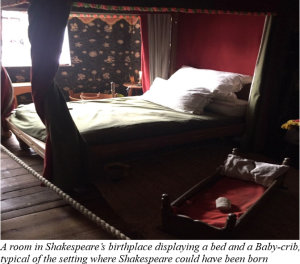 In my opinion, this house and the adjacent garden hold the most intimate and personal memories of Shakespeare’s early life. One of the bedrooms in the house has a bed and a baby-crib, which are perhaps exact replicas of furniture in the maternity room where he was born. And one can envision the garden where young Shakespeare played with his siblings and the animals his parents kept.
In my opinion, this house and the adjacent garden hold the most intimate and personal memories of Shakespeare’s early life. One of the bedrooms in the house has a bed and a baby-crib, which are perhaps exact replicas of furniture in the maternity room where he was born. And one can envision the garden where young Shakespeare played with his siblings and the animals his parents kept.
For Bengalis like us, it was also a pleasant surprise to see our own greatest poet, Rabindranath Thakur’s bust, and a plaque displayed on one edge of the garden. Below the bust, on two sides of the plinth, are the inscriptions of a poem in Bengali and English written by Rabindranath in 1916 in praise of Shakespeare on his 300th death anniversary. The bronze bust was made in Kolkata and presented to the Shakespeare Trust in 1995, the result of an initiative taken by the then Indian High Commissioner in London.
 Not much is clearly known about William Shakespeare’s childhood and schooling. It is thought that he must have attended the only school in town called King Edward VI Grammar School, and following the practice of the time, he was taught rhetoric and classical works of literature in Latin, which, according to some historians, helped him develop his skills in writing. He left school early, at fourteen years of age, apparently coinciding with his father’s legal and business troubles and falling from grace in the community. It is not known for certain where Shakespeare lived after he got married and went to London in 1584 to develop his career as a playwright, actor, poet, and theatre owner, but his wife Anna Hathaway and their three children probably lived in his birthplace with his parents until the family moved to the New Place.
Not much is clearly known about William Shakespeare’s childhood and schooling. It is thought that he must have attended the only school in town called King Edward VI Grammar School, and following the practice of the time, he was taught rhetoric and classical works of literature in Latin, which, according to some historians, helped him develop his skills in writing. He left school early, at fourteen years of age, apparently coinciding with his father’s legal and business troubles and falling from grace in the community. It is not known for certain where Shakespeare lived after he got married and went to London in 1584 to develop his career as a playwright, actor, poet, and theatre owner, but his wife Anna Hathaway and their three children probably lived in his birthplace with his parents until the family moved to the New Place.
The New Place
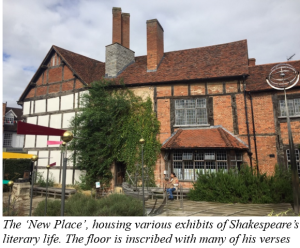
Less than a km from Shakespeare’s birthplace, on Chapel Street, is the so-called ‘New Place’, which Shakespeare purchased in 1597 for a sum of 120 pounds. It was the largest residential property in town at that time, with 20 to 30 rooms, and attests to Shakespeare’s growing wealth, thanks to his success in the theatre and literary circles of London. He was only 33 years old at the time. Although he also inherited his birthplace in 1561 after his father’s death, he chose not to live there; instead, the New Place was his family’s residence for the remaining 19 years of his life.
However, there is almost nothing left of the original ‘New Place’ that Shakespeare had purchased, except the foundation and some parts of the gardens. What we see today is the house, later renovated, in which his only granddaughter Elizabeth, his last direct descendent, lived with her husband and was called the ‘Nash House’. Shakespeare’s home, which stood next to the Nash House, was completely demolished by a new owner in 1759. The Shakespeare’s Birthplace Trust later purchased the site in 1876 and converted it into a heritage landmark, a museum for various memorabilia related to Shakespeare’s writings and literary history, and a place to host periodic Shakespeare exhibits. So, for anyone interested in his work rather than his personal life, the New Place is the place to be.
Going through the upstairs rooms of the New Place, I learned a few things about Shakespeare’s ‘Folios’. There were four recognized folios, or collections, of Shakespeare’s plays, printed between 1623 and 1685. The first folio, titled ‘Mr. William Shakespeare’s Comedies, Histories & Tragedies’, printed only seven years after his death in 1616, contains 36 plays written by him. The literary and historical importance of this tome cannot be overstated, because until then, 18 of these plays, including Macbeth, Julius Caeser, Antony and Cleopatra, As You Like It, and Taming of the Shrew, were never published before. Thanks to the efforts and investments of his friends, colleagues, and partners in the King’s Men Acting Company, London, the hand-written copies of these plays were put together in print in the first folio; otherwise, it is commonly believed that these would have been lost forever. The later folios were editions of the first folio with typographic and linguistic updates and additions of six lesser-known plays written by Shakespeare in collaboration with other playwrights of the day.
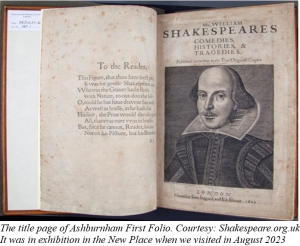 We were lucky that an exhibition of Shakespeare’s First Folio called ‘Ashburnham First Folio’, named after the 4th Earl of Ashburnham, who owned it at one time, was in progress in the New Place when we visited. It is believed that only 235 copies of the first folio survive today. I was blown away when I learned that the first folio, which was sold for 15 shillings ($200 now) upon its publication in 1623, is worth US $10 million now! When I looked at the volume, I had no idea about its monetary value. Later, when I found out, I was just awestruck by the fact that I had laid my eyes on a $10 million dollar. book.
We were lucky that an exhibition of Shakespeare’s First Folio called ‘Ashburnham First Folio’, named after the 4th Earl of Ashburnham, who owned it at one time, was in progress in the New Place when we visited. It is believed that only 235 copies of the first folio survive today. I was blown away when I learned that the first folio, which was sold for 15 shillings ($200 now) upon its publication in 1623, is worth US $10 million now! When I looked at the volume, I had no idea about its monetary value. Later, when I found out, I was just awestruck by the fact that I had laid my eyes on a $10 million dollar. book.
A film on Shakespeare’s life and the history of the global popularity of his plays is shown in a small auditorium upstairs. I found it specially fascinating how his plays, written mostly with English or European plots and characters, created a universal appeal and found an eager audience in every corner of the world. Surely, the spread of the British colonial empire and the English language helped, but it was mainly possible due to Shakespeare’s literary genius, his deep understanding of human nature, and his ability to portray that in his plays.
Anne Hathaway’s Cottage
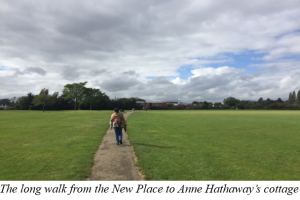
About two kilometres walk from Shakespeare’s birthplace, in the village of Shottery, is Shakespeare’s wife Anne Hathaway’s family farmhouse, where she was born and lived as a child and a young woman. The walk from Stratford’s town centre was a little long, but we found it quite enjoyable to go through quaint garden homes and meadows until we reached the idyllic cottage. The cottage sits on a few acres of land with flower and vegetable gardens and an apple orchard. Built in 1463 as a much smaller three-room house, later extended to a 12-room cottage, it was lived in by 13 generations 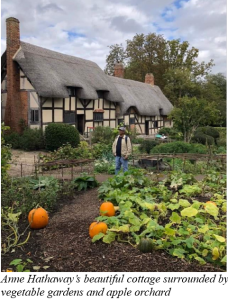 of the Hathaway family. By the 19th century, the family fortune had declined, and much of the original property was sold, including this cottage itself, where the Hathaway family continued to live as tenants. In 1892, the property was finally purchased by the Shakespeare Birthplace Trust.
of the Hathaway family. By the 19th century, the family fortune had declined, and much of the original property was sold, including this cottage itself, where the Hathaway family continued to live as tenants. In 1892, the property was finally purchased by the Shakespeare Birthplace Trust.
The beautiful cottage has been furnished with household items and furniture typical of Anne Hathaway’s time. This was the house where a teenage Shakespeare came to court Anne Hathaway, who was eight years older than him. They got married in November 1583, and six months later their daughter Susanna was born. They had their twins Judith and Hamnet in 1985. It is believed that Anne Hathaway left this cottage after marriage and the family lived in Shakespeare’s father’s home initially and later moved to the New Place, while he himself spent most of his working days in London.
Shakespeare died in Stratford-upon-Avon on April 23, 1616, apparently the same day he was born. He was only 52 years of age. Although by that time he had produced an enormous body of work, his fame was confined mainly to the theatre and literary circles of London. He became a universally acclaimed literary superstar much later, long after his death. However, Stratford always remained his home. This is where he returned from work in London, raised his family, bought real estate, conducted business, and wrote plays and sonnets. And this is where he has continuously lived for the last five years of his life. Visiting the places described here and the places we missed, notably his last resting place, I felt that if there is any place in the world where we can get a true feeling for the native son who made it really big, then Stratford-upon-Avon must be that place.

Golam Sarwar
Golam Sarwar has a Ph.D. in Geology from the City University of New York (CUNY). He had taught as adjunct lecturer in Brooklyn College, Hunter College and College of Staten Island under the CUNY system and as assistant professor in Texas A & M at Commerce. In the later part of his career, he also worked in the IT industry in Dallas Morning News and other Dallas-based companies before retiring in 2021. He currently lives in Wales and enjoys traveling and writing about it.

